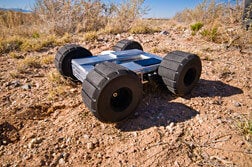
Holy crap that’s cool! Earlier this week, Sandia National Labs debuted a four wheeled surveillance bot the size of a shoe box that can navigate urban environments by jumping walls. And not just those dinky chain fences with razor wires, we are talking 25 foot high urban bunkers leaped in a single bound. The Precision Urban Hopper uses a powerful piston-leg to launch itself into the air up to 30 times in a mission. That’s a lot of wall-jumping. Check out the short but awesome video. Thanks to BotJunkie for providing the slow-motion replay.
The Precision Urban Hopper was developed at Sandia as part of DARPA’s plans to help minimize soldier casualties in urban warfare . By leaping into battle, the Hopper can relay a view of the battle field back to soldiers so they won’t have to leave cover. That’s a great way to save lives and may be adopted by domestic law enforcement and homeland security as well as armed forces overseas. DARPA plans on having the robot available for testing and delivery starting at the end of 2010.
Sandia has licensed the Hopper to Boston Dynamics for production. We’ve seen some BD products before: MIT helped Little Dog navigate terrain, Big Dog was featured in our discussion of War 2.0, and the robotic wall crawler was partly their work, too. Boston Dynamics should be able to capitalize on the successes the Hopper has already notched on its little robot belt. It is GPS guided and RC controlled. Not only can the bot leap high in the air, it can adjust its launch for different sized walls and for different landing surfaces (asphalt, concrete or sand). Just look at the video. The robot may tumble and bounce, but it keeps moving right along.
Which, actually, is something we’ve seen before quite recently. The Eye Drive robot, developed in Israel, can be hurled into battle by a user. Whether tossed or launched into the mission, these two surveillance bots work on the same concept: create a mobile surveillance platform with unique access to urban battlefields. While the Eye Drive seems to have superior guidance and observation capabilities, the Hopper can…well, hop. No tossing necessary. A blend of the two platforms could easily possess the best of both worlds.
Expendable and dependable surveillance robots will save soldiers lives by allowing them to see more and enter an engagement on their own terms. That’s a great benefit, and I think it justifies the development of these robots hands down. However, I am continually troubled by the possibilities that all it would take to modify these devices into robotic suicide bombers is five minutes with a grenade and some duct tape.
Already we’ve seen the US military enjoy great success with the Predator drone, a sort of hybrid of camera and guided missile. My concern is what happens when these robots are no longer RC, but can make decisions on their own. That sort of technology is already in development, we’ve seen automated turrets (CRAM) in Baghdad, and it will complicate the way we wage war. Perhaps in a good way, maybe in a scary way. But it’s going to happen. Hopefully robots will stay out of the decision making process when it comes to killing, and humans will use robots to stay out of situations where they can be killed. If you’re a robot, and that seems agreeable to you, please jump in the air now.
[photo credits: Sandia Labs and Randy Montoya]


